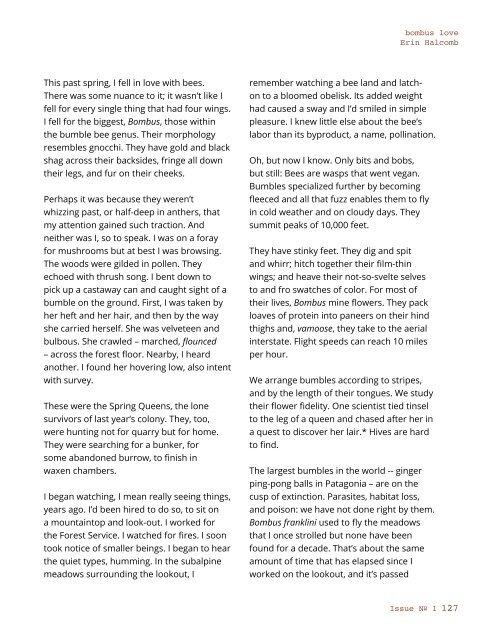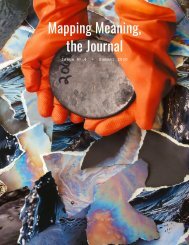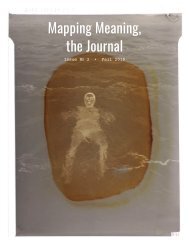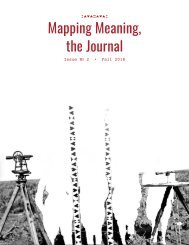Mapping Meaning, the Journal (Issue No. 1)
Create successful ePaper yourself
Turn your PDF publications into a flip-book with our unique Google optimized e-Paper software.
ombus love<br />
Erin Halcomb<br />
This past spring, I fell in love with bees.<br />
There was some nuance to it; it wasn’t like I<br />
fell for every single thing that had four wings.<br />
I fell for <strong>the</strong> biggest, Bombus, those within<br />
<strong>the</strong> bumble bee genus. Their morphology<br />
resembles gnocchi. They have gold and black<br />
shag across <strong>the</strong>ir backsides, fringe all down<br />
<strong>the</strong>ir legs, and fur on <strong>the</strong>ir cheeks.<br />
Perhaps it was because <strong>the</strong>y weren’t<br />
whizzing past, or half-deep in an<strong>the</strong>rs, that<br />
my attention gained such traction. And<br />
nei<strong>the</strong>r was I, so to speak. I was on a foray<br />
for mushrooms but at best I was browsing.<br />
The woods were gilded in pollen. They<br />
echoed with thrush song. I bent down to<br />
pick up a castaway can and caught sight of a<br />
bumble on <strong>the</strong> ground. First, I was taken by<br />
her heft and her hair, and <strong>the</strong>n by <strong>the</strong> way<br />
she carried herself. She was velveteen and<br />
bulbous. She crawled – marched, flounced<br />
– across <strong>the</strong> forest floor. Nearby, I heard<br />
ano<strong>the</strong>r. I found her hovering low, also intent<br />
with survey.<br />
These were <strong>the</strong> Spring Queens, <strong>the</strong> lone<br />
survivors of last year’s colony. They, too,<br />
were hunting not for quarry but for home.<br />
They were searching for a bunker, for<br />
some abandoned burrow, to finish in<br />
waxen chambers.<br />
I began watching, I mean really seeing things,<br />
years ago. I’d been hired to do so, to sit on<br />
a mountaintop and look-out. I worked for<br />
<strong>the</strong> Forest Service. I watched for fires. I soon<br />
took notice of smaller beings. I began to hear<br />
<strong>the</strong> quiet types, humming. In <strong>the</strong> subalpine<br />
meadows surrounding <strong>the</strong> lookout, I<br />
remember watching a bee land and latchon<br />
to a bloomed obelisk. Its added weight<br />
had caused a sway and I’d smiled in simple<br />
pleasure. I knew little else about <strong>the</strong> bee’s<br />
labor than its byproduct, a name, pollination.<br />
Oh, but now I know. Only bits and bobs,<br />
but still: Bees are wasps that went vegan.<br />
Bumbles specialized fur<strong>the</strong>r by becoming<br />
fleeced and all that fuzz enables <strong>the</strong>m to fly<br />
in cold wea<strong>the</strong>r and on cloudy days. They<br />
summit peaks of 10,000 feet.<br />
They have stinky feet. They dig and spit<br />
and whirr; hitch toge<strong>the</strong>r <strong>the</strong>ir film-thin<br />
wings; and heave <strong>the</strong>ir not-so-svelte selves<br />
to and fro swatches of color. For most of<br />
<strong>the</strong>ir lives, Bombus mine flowers. They pack<br />
loaves of protein into paneers on <strong>the</strong>ir hind<br />
thighs and, vamoose, <strong>the</strong>y take to <strong>the</strong> aerial<br />
interstate. Flight speeds can reach 10 miles<br />
per hour.<br />
We arrange bumbles according to stripes,<br />
and by <strong>the</strong> length of <strong>the</strong>ir tongues. We study<br />
<strong>the</strong>ir flower fidelity. One scientist tied tinsel<br />
to <strong>the</strong> leg of a queen and chased after her in<br />
a quest to discover her lair.* Hives are hard<br />
to find.<br />
The largest bumbles in <strong>the</strong> world -- ginger<br />
ping-pong balls in Patagonia – are on <strong>the</strong><br />
cusp of extinction. Parasites, habitat loss,<br />
and poison: we have not done right by <strong>the</strong>m.<br />
Bombus franklini used to fly <strong>the</strong> meadows<br />
that I once strolled but none have been<br />
found for a decade. That’s about <strong>the</strong> same<br />
amount of time that has elapsed since I<br />
worked on <strong>the</strong> lookout, and it’s passed<br />
<strong>Issue</strong> N o 1 127







